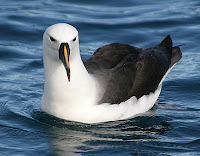 |
| Black-browned albatross. |
In the southern hemisphere, most of the 22
species of the great and fascinating albatross birds are found. Albatrosses
belong to the Diomedeidae family and are further divided into four genera; Diomedea,
Thalassarche, Phoebastria and Phoebetria. The black-browned, yellow-nosed and
shy albatrosses live far out to sea off the coast of False Bay in Cape Town.
Albatrosses are large birds, with an
impressive wingspan that can reach up to 3.5 metres (11ft) and are the largest
wingspan of any bird on Earth. These birds spend the majority of their existence
far out at sea travelling many kilometres throughout their lives.
The size of an albatross depends of the
species the bird belongs to, but all have big heads , rather angry looking expressions, with a strong and hooked
beak. They have an excellent sense of sight and smell and are well adapted for
life at sea.
Unfortunately, these birds are vulnerable to threats such
as introduced species like rats and feral cats that pose a risk to eggs, chicks
and even nesting fully grown adults. Pollution and a decline in fish numbers
due to overfishing and long-fishing also pose a threat to these mystifying
birds.
Habitat
Most of the subspecies of these extraordinary
birds are found throughout the oceans of the Southern Hemisphere, living far
out to sea off the coasts of Antarctica, Australia, South Africa and South
America. However, there are 3 species of albatrosses that are found in the
waters of the North Pacific.
 |
| Shy albatross. |
Diet
Albatrosses, like seagulls and some other
sea birds, drink the sea water as they are able to filter salt. These great
seabirds have varying diets between species but almost exclusively feed on
seafood. They eat a range of aquatic creatures, from krill, shrimps and crabs
through to lobsters, octopus and squids.
They catch their prey either by scavenging,
diving in the water or snatching up food from the surface of the water, known
as surface seizing. Some species are capable of diving 5 metres deep to reach
their potential prey.
Behaviour
These birds are mostly active during the
day when they search for the majority of their food. An incredible ability of
albatrosses is that they are able to snooze while still in the sky during their
lengthy flights across the ocean.
Their specially adapted wings and large
wingspans enable them to travel for long distances at speeds of up to 140 km/h.
Unlike most birds, they do not flap their wings but rather use gliding techniques
that aid in conserving their energy. In
actual fact an albatross uses more energy to land and take off than fly.
 |
| Yellow-nosed albatross. |
Reproduction
Albatrosses gather together in colonies on
remote islands out to sea, often nesting with other species. They are ready for
sexual maturity when they reach around five years of age but are more likely to
start breeding between the ages of seven to ten years old.
In most species, pairs are formed between
males and females which last a lifetime after a ritualised mating dance.
However, in some species, both partners may be promiscuous with others but will
raise chicks together with their partners, and even some of the same sex form a
pair and raise chicks together after mating with an opposite sexed albatross.
A single egg can be laid each year but a
pair usually has an egg every two to three years. Each parent takes turn caring
for their egg and the chick when hatched. It can take, depending on the
species, between three to ten months for the young albatross to fledge the nest
and leave for the open water.
Did you know?
Some species are able to live up to 60
years of age.

No comments :
Post a Comment